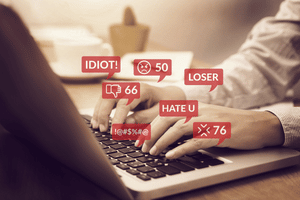

Home » Resources » Online Harassment Resources

According to a 2021 report compiled by Pew Research Center, roughly 41% of American adults have personally experienced some form of online harassment. The same report also showed that 64% of people aged 18-29 have experienced online harassment.
While the majority of those surveyed cited political opinions as the reason they were targeted, online harassment – especially through social media – can happen for many different reasons.
The purpose of this page is to provide guidance and credible resources for people dealing with a broad variety of online harassment issues, including offensive name-calling, physical threats, and sexual harassment.
Online harassment is characterized by using the Internet to disseminate threats, violence, or harm to another person or group. By Internet, we mean all information and communication technologies including social media platforms, gaming platforms, cell phone communication, and email/messaging services.
Online harassment happens in so many forms. Here are some ways in which online harassment presents:
This involves posting offensive and discriminatory remarks towards a specific group of people based on their gender, sex, race, ethnicity, nationality, religion, (dis)ability, and beliefs. Although hate speech is hurtful and offensive, it is protected by the First Amendment – which makes no definitive exception for offensive or hateful comments.
However, there are some kinds of hate speech that are not protected by the First Amendment and are thereby punishable by law:
The problem, now, is that social media has blurred the lines on what punishable hate speech is.
In real life, it’s easy to recognize statements that show imminent violent intentions and inform the appropriate authority. But on social media, a statement that threatens bodily harm might not be punished if the perpetrator doesn’t have the personal address of the victim. On the flip side, a problematic statement made by someone who might not have had any actual violent intentions might blow up and people might start attacking others physically on that basis.
Cyberbullying happens when someone posts demeaning comments, sends threatening messages, or discloses the personal information of someone else online with the purpose of humiliating them. Each state has its own laws concerning cyberbullying.
In 2012, Amanda Todd, a 15-year-old girl, posted a nine-minute video on YouTube about being blackmailed and cyberbullied by a stranger online who got ahold of her nude images. The video went viral, racking up over 17 million views. Unfortunately, Amanda committed suicide about a month after posting the video.
In October 2022, Aydin Coban, the 44-year-old Dutch man who’d cyberbullied Amanda was sentenced to 13 years in prison for his crimes.
Cyberstalking refers to repeated intimidation and threats directed at one person. It can include defamation, false accusations, and even digital vandalism – all of which are crimes that are punishable under federal and state laws.
A great example of this is the case of Parris Deshaunte Evitt, a 30-year-old Tulsa native who was arrested in 2020 for using email, Facebook, and text messages to send threatening emails and messages to an ex-girlfriend. During the court proceedings, it was disclosed that Evitt was convicted on 5 different occasions for physically assaulting the victim between the years 2012 and 2019.
In February of 2021, Mr. Evitt was found guilty of cyberstalking and was sentenced to 46 months in prison and 3 years of supervised release.
This happens when someone assumes the identity of a person, organization, or company with the intention of intimidating, deceiving, and defrauding others. Online impersonation is especially common in phishing schemes involving fake social media accounts and can severely damage the victim’s reputation.
In August 2016, Filippo Bernardini, a London-based man who worked in the publishing industry, created fake email addresses to impersonate agents, editors, and other people who worked in publishing to fraudulently get access to hundreds of pre-published manuscripts. Not only can the unauthorized release of a manuscript ruin the profit the publishing house and author stand to make, but it can also ruin the author’s reputation when the released manuscript is not edited and polished.
This went on for four years until Mr. Bernardini was arrested in late 2020. He faced up to 22 years in prison for one count of wire fraud and two counts of aggravated identity theft.
This involves publishing someone’s personal information online with the intention of harassing them. Doxxing commonly affects celebrities, politicians, and journalists, as well as gamers and hackers.
In 2021, a 56-year-old man named William Kaetz posted the home address of a United States District Judge on Facebook and Twitter, knowing that others would use the information to intimidate and threaten the judge. Kaetz was arrested and pled guilty to the crime, which led him to be sentenced to imprisonment for 16 months with three years of supervised release and a $5,000 fine.
Revenge porn occurs when a person non-consensually shares sexually explicit photos or videos of someone, usually their ex-partner or spouse. Not only is this crime punishable under state laws, but the perpetrator will likely experience severe legal consequences for their actions.
One of the most popular revenge porn cases happened in 2014 when a California woman sued her ex-boyfriend for posting sexual photos and videos of her on porn sites and using them to impersonate her on dating forums and apps. According to court documents, he threatened to make life so miserable that she would commit suicide.
Fast forward to 2018 and the court gave her $6.4 million to compensate for copyright infringement (since she took the photos and videos herself and the perpetrator posted them without her consent), severe emotional distress, and other damages.
This happens when an individual uses sexually explicit photos or videos to blackmail and extort their victim. Most times, the perpetrator threatens to send the images and videos to the victim’s friends, family, partner, or employer if they don’t do what the perpetrator asks.
This happened in 2019 when a 21-year-old man, Brandon Huu Le, contacted a 13-year-old girl via Snapchat and started having sex-based conversations with her. He took a screenshot of the conversation and threatened to publicly post it online with the girl’s name on it if she didn’t send him sexually explicit photos of herself.
The victim reported Mr. Le’s behavior to the police, and they tracked him down and arrested him. Now, the FBI is investigating the case and trying to find other individuals Mr. Le might have contacted.
To learn more about the different crimes associated with online harassment, check out this glossary from the Online Harassment Field Manual.
Unfortunately, these types of investigations can often be very labor intensive and expensive (averaging $5,000-$10,000) however for the case that Bosco Legal Services can’t help with, we are providing safe resources below that can help you navigate this challenging situation.
Social media platforms like Facebook and Twitter recognize just how prevalent online harassment is. That’s why they’ve put out resources that show people who experience harassment on these platforms how to report the situation to the correct authorities and protect their data from falling into the wrong hands.
Below are some online harassment resources for major social media platforms:
If you’re being bullied or harassed on social media, we can help you. At Bosco Legal Services, our expert social media investigators use the most advanced search tools and analysis methods to delve deep into the platforms you’re getting harassed on and gather the evidence you’ll need to prove your case, should you decide to file a lawsuit.
All you need to do is contact us via this form or call our office at (877) 353-8281.



